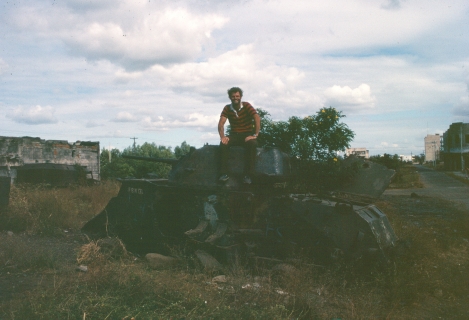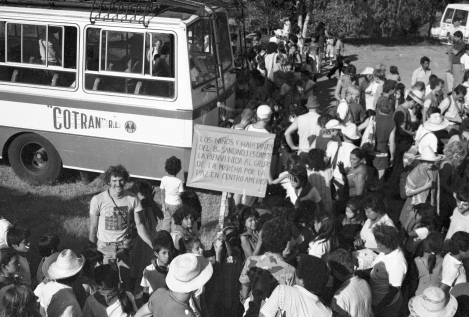|
 Here I'm sitting on one of Somoza's tanks, rusting away in downtown Managua.
Here I'm sitting on one of Somoza's tanks, rusting away in downtown Managua.
On December 23, 1972, an earthquake centered beneath Managua, and lasting two hours, killed upwards of 10,000
people and left 300,000 homeless.
Washington's favorite dictator, Anastasio Somoza Debayle, received
millions of dollars in foreign aid for urban renewal and repair. Somoza pocketed virtually all of the money,
which turned even his former cronies against him—one factor which
led ultimately to his downfall. (Visible in the background is Managua's still-devastated central portion. With the contra war going on, the
Sandinistas could not possibly take on the project of rebuilding the city.)
The other factor was the cold-blooded murder, on June 20, 1979, of ABC television correspondent
Bill Stewart by Somoza's National Guard. Stewart had gone to cover a firefight between the Guard and Sandinista
insurgents. The killing was filmed in it's entirety by Stewart's cameraman, who had remained at a distance, and who
successfully smuggled the
film out of Nicaragua. When Stewart's murder was shown on the U.S. evening news, it led to such outrage that
even the Republicans in Congress had to abandon their Pavlovian resistance to President Carter's somewhat
reluctant efforts to persuade Somoza
to step down.
According to
Wikipedia, "in a strange diplomatic twist, the United States government refused to help ABC and
Stewart's family bring
Stewart's body back to the United States; eventually, the German government stepped in and made the
arrangements." (Let me assure the visitor that I wrote my quip on the Republicans before hitting on the
Wikipedia site for information on Stewart. I welcome information on the Carter
Administration's alleged "refusal" to help Stewart's family recover his body.)
|
 Steve flashes a big smile as we prepare to march in Managua's Barrio Sandino.
Steve flashes a big smile as we prepare to march in Managua's Barrio Sandino.